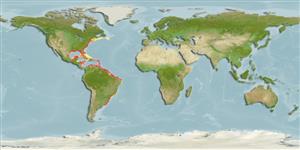Malacostraca |
Decapoda |
Portunidae
Environment: milieu / climate zone / تغييرات عمق / distribution range
بوم شناسي
موجوداتی که در محدوده وسیعی از آبهای آزاد از نزدیک بستر و یا روی کف بستر، در قسمت های میان آبی تا سطح آب و در برخی گونه ها با قابلیت پرواز، زندگی و تغذیه می کنند.; آب شيرين; لب شور; تغييرات عمق 0 - 90 m (مرجع 109245), usually 0 - 35 m (مرجع 367). Tropical; 6°C - 30°C (مرجع 105839), preferred 25°C (مرجع 107945); 47°N - 36°S, 125°W - 34°W
Western Atlantic: From Nova Scotia to Rio de la Plata, Argentina. Introduced in the eastern Atlantic, North Sea, Mediterranean Sea, Adriatic Sea, Black Sea and Indo-Pacific. Tropical to temperate.
Length at first maturity / Size / Weight / سن
بلوغ: Lm 12.8, range 13 - 13 cm Max length : 22.7 cm WD جنس نر / بدون خواص جنسي; (مرجع 367); بيشينه سن گزارش شده: 3.00 سال ها (مرجع 105839)
Carapace more than twice as broad as long; 9 blunt to acuminate teeth (outer orbital tooth and strong lateral spine included) on arched anterolateral margin; front (excluding inner orbital angles) bearing 2 obtuse to acuminate, broadly triangular teeth with often sinuous inner margins longer than outer margins. Much of convex dorsal surface smooth, but scattered and transverse lines of fine granules; sculpture of regions near center varying from low and smooth to rather sharply raised relief with crowded granules; pincers strong, dissimilar, and ridged longitudinally; fifth legs flattened in form of paddles. Males with T-shaped abdomen level of thoracic sternite 4; slender first pleopods with membranous tip reaching beyond suture between thoracic sternites 4 and 5; sinuously curved overlapping proximally and armed distally with a row of large and small retrogressive spinules. Color: greyish, bluish, or brownish green. Males with propodi of chelae blue on inner and white on outer surfaces, fingers blue on inner and white on outer surfaces and tipped with red. Mature females with orange fingers on chelae tipped with purple. Underparts off-white with tints of yellow and pink. Color variations is associated with sexual dimorphism and molt cycle.
An epibenthic omnivore, that is active and abundant in shallow habitats (Ref. 087949). Longevity was estimated from a population of blue crabs in Chesapeake Bay (Ref. 105839). Benthopelagic (Ref. 97531). Hatching occurs in mouths of estuaries and shallow marine waters, development of larvae progresses in the ocean, followed by migration of megalopae and young crabs back into estuarine waters to mature into adults (Ref. 367). Found on soft bottoms (Ref. 106866). Burrows in muddy-sand bottoms (Ref. 108781). Juveniles occur on seagrasses. Highly cannibalistic; adult conspecifics are observed attacking tethered juveniles (Ref. 106866). Appears to be an opportunistic feeder (Ref. 108779).
Members of the order Decapoda are mostly gonochoric. Mating behavior: Precopulatory courtship ritual is common (through olfactory and tactile cues); usually indirect sperm transfer.
مآخذ اصلی
مراجع | هماهنگ كننده | همكاران
Tavares, M. 2003 True Crabs. pp. 327-352. In Carpenter, K.E. (ed.) The living marine resources of the Western Central Atlantic. Volume1: introdution, molluscs, crustaceans, hagfishes, sharks, batoid fishes, and chimaeras. FAO Species Identification Guide for Fishery Purposes and American Society of Ichthyologists and Herpetologists Special PublicationNo. 5. Rome, FAO. pp. 1-600. (مرجع 367)
وضعيت در فهرست قرمز IUCN
(مرجع 130435: Version 2025-1)
وضعيت از نظر سايتس (مرجع 108899)
Not Evaluated
Not Evaluated
خطر برای انسان ها
استفاده انسانی
ماهي گيري – شيلات: تجاري
FAO - آبزي پروري: production; ماهي گيري – شيلات: landings, نمايه گونه | FishSource | Sea Around Us
ابزارها
اطلاعات بيشتر
Human RelatedStamps, coins, misc.
منابع اينترنتي
Estimates based on models
Preferred temperature
(Ref.
115969): 12.3 - 28, mean 24.4 (based on 788 cells).
جهندگی
زياد, كمينه زمان لازم براي دو برابر شدن جمعيت ، كمتر از 15 ماه (K=0.5-1.59; tmax=3).
Prior r = 0.89, 95% CL = 0.59 - 1.34, Based on 2 full stock assessments.
Fishing Vulnerability
Low vulnerability (16 of 100).
Climate Vulnerability
Low to moderate vulnerability (33 of 100).
Nutrients : Calcium = 109 [35, 184] mg/100g; Iron = 1.59 [1.21, 1.97] mg/100g; Protein = 20.2 [19.2, 21.3] %; Omega3 = 0.285 [0.185, 0.386] g/100g; Selenium = 48.3 [-31.7, 128.3] μg/100g; VitaminA = 0 μg/100g; Zinc = 1.79 [1.17, 2.40] mg/100g (wet weight); based on
nutrient studies.
